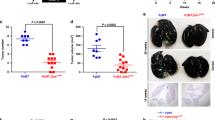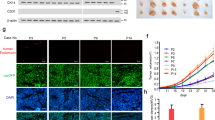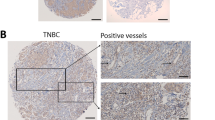Abstract
Most cases of breast cancer (BrCa) mortality are due to vascular metastasis. BrCa cells must intravasate through endothelial cells (ECs) to enter a blood vessel in the primary tumor and then adhere to ECs and extravasate at the metastatic site. In this study we demonstrate that inhibition of hypoxia-inducible factor (HIF) activity in BrCa cells by RNA interference or digoxin treatment inhibits primary tumor growth and also inhibits the metastasis of BrCa cells to the lungs by blocking the expression of angiopoietin-like 4 (ANGPTL4) and L1 cell adhesion molecule (L1CAM). ANGPTL4 is a secreted factor that inhibits EC–EC interaction, whereas L1CAM increases the adherence of BrCa cells to ECs. Interference with HIF, ANGPTL4 or L1CAM expression inhibits vascular metastasis of BrCa cells to the lungs.
This is a preview of subscription content, access via your institution
Access options
Subscribe to this journal
Receive 50 print issues and online access
$259.00 per year
only $5.18 per issue
Buy this article
- Purchase on SpringerLink
- Instant access to full article PDF
Prices may be subject to local taxes which are calculated during checkout








Similar content being viewed by others
Change history
15 January 2021
A Correction to this paper has been published: https://doi.org/10.1038/s41388-020-01618-z
23 May 2023
This article has been retracted. Please see the Retraction Notice for more detail: https://doi.org/10.1038/s41388-023-02720-8
References
Belanger AJ, Lu H, Date T, Liu LX, Vincent KA, Akita GY et al. (2002). Hypoxia up-regulates expression of peroxisome proliferator-activated receptor gamma angiopoietin-related gene (PGAR) in cardiomyocytes: role of hypoxia inducible factor 1α. J Mol Cell Cardiol 34: 765–774.
Bos R, van der Groep P, Greijer AE, Shvarts A, Meijer S, Pinedo HM et al. (2003). Levels of hypoxia-inducible factor 1α independently predict prognosis in patients with lymph node negative breast carcinoma. Cancer 97: 1573–1581.
Bos R, Zhong H, Hanrahan CF, Mommers EC, Semenza GL, Pinedo HM et al. (2001). Levels of hypoxia-inducible factor 1α during breast carcinogenesis. J Natl Cancer Inst 93: 309–314.
Buffa FM, Harris AL, West CM, Miller CJ . (2010). Large meta-analysis of multiple cancers reveals a common, compact and highly prognostic hypoxia metagene. Br J Cancer 102: 428–435.
Cailleau R, Young R, Olivé M, Reeves Jr WJ . (1978). Breast tumor cell lines from pleural effusions. J Natl Cancer Inst 53: 661–674.
Caniggia I, Mostachfi H, Winter J, Gassmann M, Lye SJ, Kuliszewski M et al. (2000). Hypoxia-inducible factor 1 mediates the biological effects of oxygen on human trophoblast differentiation through TGFβ3 . J Clin Invest 105: 577–587.
Chambers AF . (2009). MDA-MB-435 and M14 cell lines: identical but not M14 melanoma? Cancer Res 69: 5292–5293.
Chintala S, Tóth K, Cao S, Durrani FA, Vaughan MM, Jensen RL et al. (2010). Se-methylselenocysteine sensitizes hypoxic tumor cells to irinotecan by targeting hypoxia-inducible factor 1α. Cancer Chemother Pharmacol 66: 899–911.
Dales JP, Garcia S, Meunier-Carpentier S, Andrac-Meyer L, Haddad O, Lavaut MN et al. (2005). Overexpression of hypoxia-inducible factor HIF-1α predicts early relapse in breast cancer: retrospective study in a series of 745 patients. Int J Cancer 116: 734–739.
Dewhirst MW, Cao Y, Moeller B . (2008). Cycling hypoxia and free radicals regulate angiogenesis and radiotherapy response. Nat Rev Cancer 8: 425–437.
Erler JT, Bennewith KL, Cox TR, Lang G, Bird D, Koong A et al. (2009). Hypoxia-induced lysyl oxidase is a critical mediator of bone marrow cell recruitment to form the premetastatic niche. Cancer Cell 15: 35–44.
Erler JT, Bennewith KL, Nicolau M, Dornhöfer N, Kong C, Le QT et al. (2006). Lysyl oxidase is essential for hypoxia-induced metastasis. Nature 440: 1222–1226.
Fukuda R, Zhang H, Kim JW, Shimoda L, Dang CV, Semenza GL . (2007). HIF-1 regulates cytochome oxidase subunits to optimize efficiency of respiration in hypoxic cells. Cell 129: 111–122.
Galaup A, Cazes A, Le Jan S, Philippe J, Connault E, Le Coz E et al. (2006). Angiopoietin-like 4 prevents metastasis through inhibition of vascular permeability and tumor cell motility and invasiveness. Proc Natl Acad Sci USA 103: 18721–18726.
Generali D, Berruti A, Brizzi MP, Campo L, Bonardi S, Wigfield S et al. (2006). Hypoxia-inducible factor-1α expression predicts a poor response to primary chemoendocrine therapy and disease-free survival in primary human breast cancer. Clin Cancer Res 12: 4562–4568.
Giatromanolaki A, Koukourakis MI, Simopoulos C, Polychronidis A, Gatter KC, Harris AL et al. (2004). c-erbB-2 related aggressiveness in breast cancer is hypoxia inducible factor-1α dependent. Clin Cancer Res 10: 7972–7977.
Gupta GP, Nguyen DX, Chiang AC, Bos PD, Kim JY, Nadal C et al. (2007). Mediators of vascular remodelling co-opted for sequential steps in lung metastasis. Nature 446: 765–770.
Helczynska K, Larsson AM, Holmquist-Mengelbier L, Bridges E, Fredlund E, Borgquist S et al. (2008). Hypoxia-inducible factor 2α correlates to distant recurrence and poor outcome in invasive breast cancer. Cancer Res 68: 9212–9220.
Issa Y, Nummer D, Seibel T, Müerköster SS, Koch M, Schmitz-Winnenthal F et al. (2009). Enhanced L1CAM expression on pancreatic tumor endothelium mediates selective tumor cell transmigration. J Mol Med 87: 99–112.
Krishnamachary B, Zagzag D, Nagasawa H, Rainey K, Okuyama H, Baek JH et al. (2006). Hypoxia-inducible factor-1-dependent repression of E-cadherin in von Hippel-Lindau tumor suppressor-null renal cell carcinoma mediated by TCF3, ZFHX1A, and ZFHX1B. Cancer Res 66: 2725–2731.
Kronblad A, Jirstrom K, Ryden L, Nordenskjold B, Landberg G . (2006). Hypoxia inducible factor-1α is a prognostic marker in premenopausal patients with intermediate to highly differentiated breast cancer but not a predictive marker for tamoxifen response. Int J Cancer 118: 2609–2016.
Liao D, Corle C, Seagroves TN, Johnson RS . (2007). Hypoxia-inducible factor-1α is a key regulator of metastasis in a transgenic model of cancer initiation and progression. Cancer Res 67: 563–572.
Liotta LA, Kohn EC . (2000) In: Bast, RC, Kufe, DW, Pollock, RE, Weichselbaum, RR, Holland, JF, Frei E(ed). Cancer Medicine. B.C. Decker: Hamilton, Canada, pp 121–131.
Manalo DJ, Rowan A, Lavoie T, Natarajan L, Kelly BD, Ye SQ et al. (2005). Transcriptional regulation of vascular endothelial cell responses to hypoxia by HIF-1. Blood 105: 659–669.
Melillo G . (2007). Targeting hypoxia cell signaling for cancer therapy. Cancer Metastasis Rev 26: 341–352.
Minn AJ, Gupta GP, Siegel PM, Bos PD, Shu W, Giri DD et al. (2005). Genes that mediate breast cancer metastasis to lung. Nature 436: 518–524.
Nishi H, Nakada T, Hokamura M, Osakabe Y, Itokazu O, Huang LE et al. (2004). Hypoxia-inducible factor-1 transactivates transforming growth factor-beta3 in trophoblast. Endocrinology 145: 4113–4118.
Padua D, Zhang XH, Wang Q, Nadal C, Gerald WL, Gomis RR et al. (2008). TGFβ primes breast tumors for lung metastasis seeding through angiopoietin-like 4. Cell 133: 66–77.
Pal SK, Childs BH, Pegram M . (2011). Triple negative breast cancer: unmet medical needs. Breast Cancer Res Treat 125: 627–636.
Palmieri C, Krell J, James CR, Harper-Wynne C, Misra V, Cleator S et al. (2010). Rechallenging with anthacyclines and taxanes in metastatic breast cancer. Nat Rev Clin Oncol 7: 561–574.
Schindl M, Schoppmann SF, Samonigg H, Hausmaninger H, Kwasny W, Gnant M et al. (2002). Overexpression of hypoxia-inducible factor 1α is associated with an unfavorable prognosis in lymph node-positive breast cancer. Clin Cancer Res 8: 1831–1837.
Semenza GL . (2010). Defining the role of hypoxia-inducible factor 1 in cancer biology and therapeutics. Oncogene 29: 625–634.
Subarsky P, Hill RP . (2003). The hypoxic tumor microenvironment and metastatic progression. Clin Exp Metastasis 20: 237–250.
Tafani M, Russo A, Di Vito M, Sale P, Pellegrini L, Schito L et al. (2010). Up-regulation of pro-inflammatory genes as adaptation to hypoxia in MCF-7 cells and in human mammary invasive carcinoma microenvironment. Cancer Sci 101: 1014–1023.
Talmadge JE, Fidler IJ . (2010). AACR centennial series: the biology of cancer metastasis: historical perspective. Cancer Res 70: 5649–5669.
Trastour C, Benizri E, Ettore F, Ramaioli A, Chamorey E, Pouyssegur J et al. (2007). HIF-1α and CA IX staining in invasive breast carcinomas: Prognosis and treatment outcome. Int J Cancer 120: 1443–1450.
Ueno M, Maeno T, Nomura M, Aoyagi-Ikeda K, Matsui H, Hara K et al. (2011). Hypoxia-inducible factor-1α mediates TGF-β-induced PAI-1 production in alveolar macrophages in pulmonary fibrosis. Am J Physiol Lung Cell Mol Physiol 300: L740–L752.
Vaupel P, Mayer A, Höckel M . (2004). Tumor hypoxia and malignant progression. Meth Enzymol 381: 355–354.
Verheul HM, Salumbides B, Van Erp K, Hammers H, Qian DZ, Sanni T et al. (2008). Combination strategy targeting the hypoxia inducible factor-1α with mammalian target of rapamycin and histone deacetylase inhibitors. Clin Cancer Res 14: 3589–3597.
Vleugel MM, Greijer AE, Shvarts A, van der Groep P, van Berkel M, Aarbodem Y et al. (2005). Differential prognostic impact of hypoxia induced and diffuse HIF-1α expression in invasive breast cancer. J Clin Pathol 58: 172–177.
Wang GL, Jiang BH, Rue EA, Semenza GL . (1995). Hypoxia-inducible factor 1 is a basic-helix-loop-helix-PAS heterodimer regulated by cellular O2 tension. Proc Natl Acad Sci USA 92: 5510–5514.
Yamamoto Y, Ibusuki M, Okumura Y, Kawasoe T, Kai K, Ivama K et al. (2008). Hypoxia-inducible factor 1α is closely linked to an aggressive phenotype in breast cancer. Breast Cancer Res Treat 110: 465–475.
Zhang H, Qian DZ, Tan YS, Lee K, Gao P, Ren YR et al. (2008). Digoxin and other cardiac glycosides inhibit HIF-1α synthesis and block tumor growth. Proc Natl Acad Sci USA 105: 19579–19586.
Acknowledgements
We are grateful to Karen Padgett of Novus Biologicals for generous gifts of antibodies against HIF-1α, HIF-2α and L1CAM. This work was supported by the Emerald Foundation, the National Institutes of Health (U54-CA143868) and the Johns Hopkins Institute for Cell Engineering. DMG was supported by the Postdoctoral Training Program in Nanotechnology for Cancer Medicine (T32-CA130840). GLS is the C Michael Armstrong Professor at Johns Hopkins University School of Medicine.
Author information
Authors and Affiliations
Corresponding author
Ethics declarations
Competing interests
The authors declare no conflict of interest.
Additional information
Supplementary Information accompanies the paper on the Oncogene website
Supplementary information
About this article
Cite this article
Zhang, H., Wong, C., Wei, H. et al. RETRACTED ARTICLE: HIF-1-dependent expression of angiopoietin-like 4 and L1CAM mediates vascular metastasis of hypoxic breast cancer cells to the lungs. Oncogene 31, 1757–1770 (2012). https://doi.org/10.1038/onc.2011.365
Received:
Revised:
Accepted:
Published:
Issue Date:
DOI: https://doi.org/10.1038/onc.2011.365
Keywords
This article is cited by
-
UBE3B promotes breast cancer progression by antagonizing HIF-2α degradation
Oncogene (2023)
-
Iron Deficiency Increases Phosphorylation of SP1 to Upregulate SPNS2 Expression in Hepatocellular Carcinoma
Biological Trace Element Research (2023)
-
Identifying drivers of breast cancer metastasis in progressively invasive subpopulations of zebrafish-xenografted MDA-MB-231
Molecular Biomedicine (2022)
-
HIF-1 Interacts with TRIM28 and DNA-PK to release paused RNA polymerase II and activate target gene transcription in response to hypoxia
Nature Communications (2022)
-
Danlou Tablet Improves Chronic Intermittent Hypoxia-Induced Dyslipidemia and Arteriosclerosis by HIF-1α-Angptl4 mRNA Signaling Pathway
Chinese Journal of Integrative Medicine (2022)



